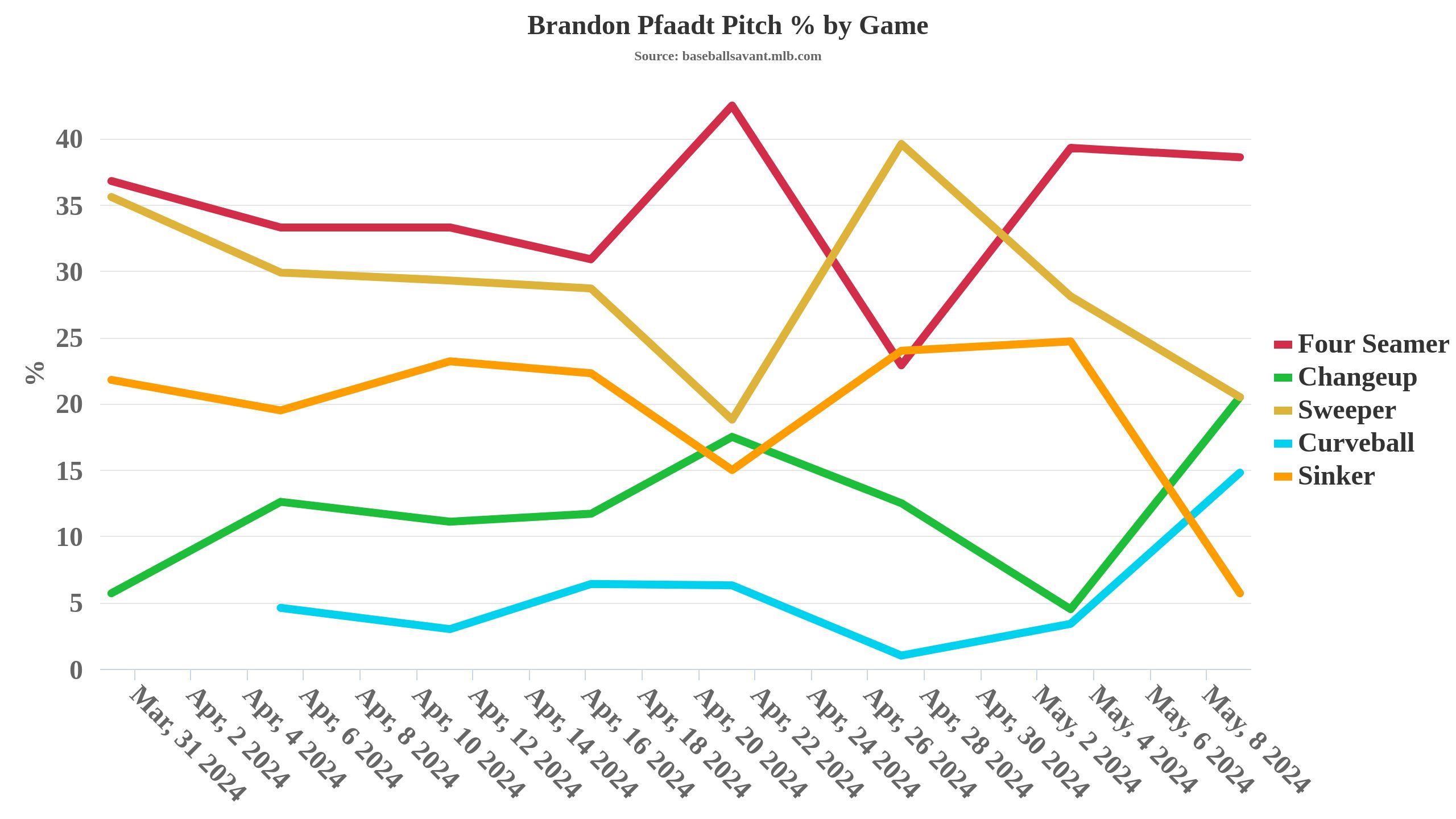Brandon Pfaadt only has 165 total big-league innings, yet it feels like there have been enough highs and lows to fill 500. From an 8.37 ERA in his first five starts before a demotion to a 3.27 ERA in five postseason starts and everything in between, Pfaadt has already experienced some of the highest highs and lowest lows.
We’ve seen the “playoff tax” applied to rookies who have a breakout playoff run but often fail to immediately show their playoff gains in the year after. Pfaadt was appropriately attributed the “playoff tax” but also had the wrinkle of making mechanical changes between his regular season struggles and playoff success. So, coming into 2024, there was some hesitancy about who Pfaadt would be this season. Projections generally had him in the 4.50 ERA range, which was spot on.
Pfaadt has a 4.60 ERA and 3.39 FIP in 47 innings this season, though it’s come with the lowest strikeout rate (boo!) and lowest walk rate (yay!) of his career. What gives me hope is that we’ve already seen two different pitchers in terms of usage in just eight starts.
Pfaadt’s first four starts showed little change in terms of usage. In his last four starts, he’s gone into his bag of tricks, significantly changing what’s what from start to start.

I can’t say it’s completely night and day when it comes to comparing the results, but his surface stats have improved while his strikeouts and walks have taken a slight hit.
Pfaadt’s exceptional walk rate in the first four starts was partly due to a 78% first-pitch strike rate, which was 8% higher than the next closest starter (Logan Webb). Although that probably made every youth coach think Pfaadt would become an All-Star, he threw too many pitches in the zone. His first-pitch pitch-type selection nearly mimicked his season averages to that point, so it was easy for hitters to know what was coming and attack.
Hitters were swinging 46.5% of the time on Pfaadt’s first pitch, the most among starters through April 20th (min. 100 pitches). And those swings brought damage with them: a brutal .542 wOBA and .662 xSLG came from swings on the first pitch.
In Pfaadt’s last four starts, his first-pitch strike rate was 70.4%, which is still in the 89th percentile but not abnormally high. First-pitch swings were much better, producing a significantly improved .223 wOBA and .519 xSLG. On the pitch mix side, Pfaadt relied more on his fastball and sweeper but got vastly better results.
The sweeper has extreme results on both ends of the spectrum, as it’s the difference in six vs. two balls in play. However, the small sample doesn’t mean the data is meaningless. In Pfaadt’s first four games, his 0-0 sweepers were thrown right to where he normally locates the pitch. In his last four games, he’s toyed with using it as a front-door/back-door called strike (depending on the hitter’s handedness) or to chase an early whiff out of the zone.

So far, that’s been the difference between a Marcell Ozuna three-run HR and getting a whiff from Fernando Tatis Jr, among other results.
The league is swinging at the first pitch 31% of the time, on pace to be the highest in the pitch-tracking era. There’s a better chance of getting a meatball in an 0-0 count, so hitters are jumping on the most hittable pitch they may get in any given at-bat. If you know what you’re looking for, you might as well take a big swing and hope for the best, given that the consequence is often a 0-1 count. By mixing up the location, hitters aren’t getting what they expect when they see a spinner coming out of Pfaadt’s hand.
Across the whole season, the sweeper has been exceptional at getting whiffs. It pairs an elite 22.0% swinging strike rate (97th percentile) and a formidable 29.5% ICR (75th percentile), resulting in a pitch that can suppress contact and get whiffs. It grades out at 134 Stuff+, the 10th-best slider/sweeper among qualified pitchers. When it’s on, like when he went to it nearly 40% of the time against Seattle, no one can touch Pfaadt.
The problem is that the sweeper is the only plus pitch in his arsenal, and there’s a limit to how much one can rely on their only pitch. It’s his main pitch to righties, which he supplements with a fastball/sinker mix to keep hitters honest. The sinker & sweeper tunnel is as good as it gets, leading Pfaadt to hold RHB to just a .198 average and with a 26.0% strikeout rate. He’s never had a problem with righties, but seeing Pfaadt excel against them excites me for the future.
As for lefties, he’s shown two different approaches from his first four starts to his last four starts. Though there hasn’t been much improvement in results yet, Pfaadt is throwing 5% more changeups and utilizing the fastball less. He may be limited against lefties because his main pitch is the sweeper, but he has four other pitches that he could use as a kitchen sink approach. If he doesn’t know what PitchCom’s about to tell him, then neither does the hitter.
There’s a lot to still get excited about for Brandon Pfaadt, even though we’ve already seen so much of him. He’s already made one big adjustment and is benefitting from it, but this could be the beginning from Brent Strom and the Diamondbacks coaching staff.
